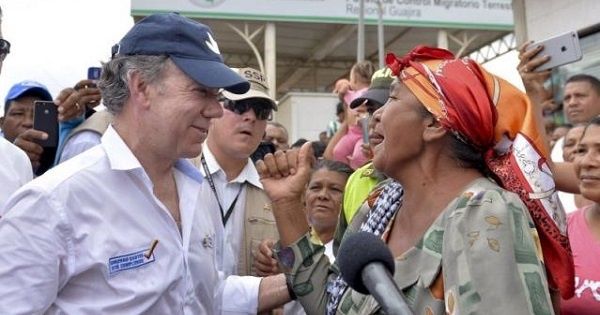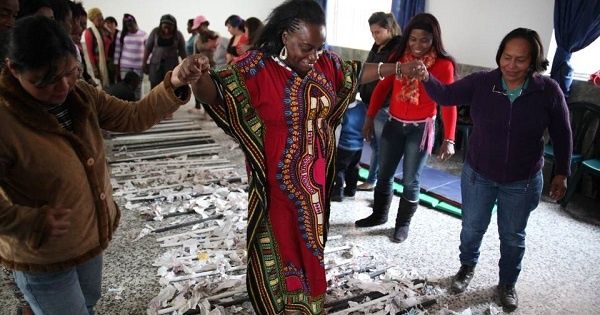Maria takes my hand, leading me to the edge of the river behind her house. She points across the river bank to the other side, telling me how over several years she watched paramilitary soldiers regularly kill people and dump them in the water to be carried away with the current, contaminating the water, literally and spiritually, with death.
Some say Colombia’s rivers constitute the largest grave in the world. Home for her, I see, is memoried through such proximity to death and the phantoms that remain for her to resolutely recall.
As Colombia’s peace process between the government and the rebel group known as FARC continues with a likely failure to meet the self-imposed Mar. 23 deadline for completing negotiations, many of Colombia’s most marginalized communities remain vulnerable to human rights violations perpetrated by state and paramilitary forces, armed insurgent groups, and the prevalent organized crime groups known as “bandas criminales” or BaCrim in Colombia.
Despite an official demobilization of paramilitary forces from 2003 to 2006, many of Colombia’s state-backed paramilitary troops simply metamorphosed into the BaCrim, transferring resources and taking new form as the “monster with a thousand heads.”
This has meant that while Colombia has managed to improve its reputation in the international arena, the reality on the ground is that the violence of the decades-long conflict continues.
Colombia stands as the Latin American country with the highest rate of enforced disappearances, exceeding the combined numbers of the Dirty War in Argentina, Uruguay, and Paraguay; Chile’s Dictatorship period; and the Central American periods of conflict.
With an official registry of over 60,000 enforced disappearances, some estimate over 250,000 from the entire course of the internal war. At least 200,000 have been killed during this time, including at the hands of the Colombian Army through what came to be called the ‘False Positives Scandal.’
While the official national discourse places culpability for these crimes with the country’s armed guerrilla groups, national and international human rights organizations have recognized that 75-85 percent of these crimes have been at the hand of Colombia’s armed forces and state-backed paramilitaries and BaCrim. Furthermore, over 6.8 million people have been internally displaced, mostly from rural areas to Colombia’s major urban centers.
The Conflict’s Impact on Women

Colombia's President Juan Manuel Santos (L) listens a Wayuu indigenous woman speak in La Guajira, home to major structural discrimination. | Colombian Presidency Handout via Reuters
Despite how much they are impacted, women tend to be underrepresented in media and scholarly accounts of Colombia’s dirty war while contending with immense forms of discrimination and violence, particularly in a culture of sexism that often turns a blind eye to femicide.
The government of Colombia has recognized the ongoing problem of sexual violence used as a weapon of war for recruitment, control of territories, punishment for allegiances to different groups, and terrorizing communities throughout the country’s internal conflict.
This includes acts such as sexual harassment; forced domestic labor; rape; forced prostitution and sexual slavery; forced sterilizations, pregnancies and abortions; and forced copulation with family members. But, according to one human rights defender, more recent killings of women in rural areas are being registered as ‘domestic violence,’ without any investigation into the actual conditions under which such violence is taking place.
A report by Casa de la Mujer documents that between 2001 and 2009, about half a million women were victims of sexual violence directly related to Colombia’s armed conflict, and according to Colombian Congresswoman Angela Robledo, it has been the Colombian Army and police forces at the forefront of these perpetrations.
Reports also point to practices by paramilitary and guerrilla forces, for example, with the trafficking of young women from rural zones to urban centers where they are often kept as domestic labor-sex slaves in the service of the illegal armed groups – under which any protest of their conditions is a risk of their lives. Further, the social stigma attached to sexual violation in these contexts has often resulted in the ostracization of victims and the children born from these rapes.
Militarized Violence and the Culture of Fear
Across Colombia, the militarized regulation of daily social life of families has been routinized, making the home and the women who run it a target of control and subjugation. For example, in the case of the Cauca region’s Afro-Colombian communities, paramilitaries have forcibly entered people’s homes, ordered them around, dictating how they could dress, what they could watch on television, what they could listen to on the radio, and where they could go. The targeting of Afro-descendant and Indigenous women in these ways has been part of a larger systematic effort of cultural erasure toward establishing an environment of fear and repression with the goal of expropriation of land and natural resources.

Maria Eugenia Urrutia, head of the Association of Afro-Colombian women for Peace (Afromupaz), crosses a symbolic bridge during a therapy session she runs for rape survivors in Bogota, in April 2014. | Reuters
As men are the main targets for disappearances and extrajudicial killings, women face the burden of adjusting their lives to financially support their families and make difficult decisions regarding whether to flee the violence and contend with the challenges of forced displacement. In this context, women have also been disproportionately charged with pursuing processes for truth and justice, and rebuilding communities in the aftermaths of the conflict’s environmental, cultural, economic, and psychological devastation.
While some legal frameworks are in place specifically to protect women, impunity and bureaucratic inefficiency remain major roadblocks to diminishing the rate at which these crimes happen, or to improving the resources available for victims. And the security and protections offered to human rights defenders remain precarious. As a result, women organizing for economic, social, and political rights face ongoing death threats and physical and psychological violence meant to cultivate a culture of fear.
Resistance in Colombia Begins With Women
Afro-Colombian and Indigenous women, as some of the country’s most vulnerable populations, insist on having a voice and a place in leadership in the work of building and realizing collective dreams for peace, dignity, and life. Despite the widespread difficulties and realities of gendered violence in Colombia’s territory, women remain at the forefront of movements and political efforts, including in the current government-FARC peace negotiations.
Representatives of diverse national women’s organizations and the LGBTQI community have fought to gain a seat at the table in the Havana Peace Talks, including female ex-combatants (up to 40 percent of FARC’s troops are women) – who face different challenges in demobilization and reintegration than do men.
.@PiedadCordoba says Afro-Latinos are ‘totally invisible’.http://t.co/AwpZQEkXML pic.twitter.com/K7B3c5Hmv2
— teleSUR English (@telesurenglish) September 30, 2015
At the local level, women continue to take on leadership roles in human rights advocacy and policy change efforts, psycho-social healing and memory projects, and community organizing in land rights struggles and efforts at seeking truth and justice. From the City of Women built by the Liga de Mujeres Desplazadas, to the dissent and mobilizations by La Ruta Pacifica, to the Marcha Patriotica – (Colombia’s New Left political and social movement founded by Afro-Colombian human rights leader and former senator, Piedad Cordoba) – the work of justice and peace continues.
These and many other collective efforts bring feminist and women’s concerns to the fore, demanding an end to the violence and oppression they have survived and insisting on recognition of the rights of all human beings.
Ten years after his disappearance, Maria’s son has still not been found. “I dream of his return,” she tells me. “I dream that all our families are whole again, that we find peace – but not a peace defined for us by others. A peace we define together, for ourselves.”
Heidi Andrea Restrepo Rhodes is a scholar-activist and archival researcher with the Center for Justice and Accountability and Cardozo Law School Human Rights and Atrocity Prevention Clinic. A Doctoral Graduate Fellow in Political Science at CUNY's Graduate Center, she currently resides in Brooklyn.